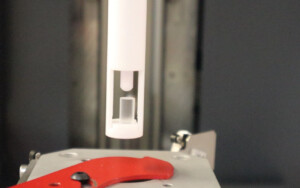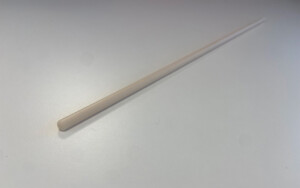An overview of Thermomechanical Analysis
Thermomechanical analysis measures the variation in dimensions of materials as a function of temperature. It is called TMA (for thermomechanical analysis) or dilatometry.

TMA – Introduction to Thermomechanical Analysis
Thermomechanical analysis is a technique based on dimensional variations measurements of a sample of material to be characterized when this sample is exposed to a given temperature or to a temperature variation program.
The instrument, sometimes called a dilatometer, designed to apply this technique is mainly composed of :
- A measuring head capable of continuously measuring the dimensional change of the sample in a chosen axis
- A sample holder system attached to this measuring head
- An oven, in which the sample and the sample holder are placed during the experiment. This oven is equipped with a temperature control system that allows it to heat, cool, and maintain the temperature according to a profile programmed by the user.
- A gas management system to control the composition and renewal of the atmosphere around the sample. Depending on the application, the nature of the gas(es) used can be chosen to generate an inert atmosphere, or on the contrary, a reactive one when a specific reaction of the sample is to be analyzed.
The thermomechanical analyzers cover the needs of research and development of materials in different forms (solids, powders) over a very wide temperature range.
TMA and dimensional change measurements
The analysis of dimensional variations as a function of time or temperature allows to characterize the phenomena of expansion and densification. Let us consider for example a single material part within a multi-material system. If its dimension between the temperature of the system at rest and its temperature in operation varies a lot, it is essential during the mechanical design of the system, to take into account this difference. Otherwise, it will be subjected to mechanical stress that will affect its operation and the part’s lifetime.
Another typical application of dimensional variation measurements is the characterization of densification during powder sintering processes. Sintering is used to manufacture complex shaped parts from a blend of ceramic or metal powders and a binder. This principle is used for example in some 3D printing techniques. The densification rate has a critical influence on the mechanical strength of the sintered or printed part.

TMA and temperature measurements
When the sample is heated in the analyzer and undergoes certain transformations such as softening, glass transition or sintering in the case of a powder, its rate of dimensional change will gradually change. This change will be detected by the sensor and recorded by the analyzer. Thus, the analysis of a curve representing the variation of dimension according to the temperature makes it possible to characterize the temperatures at which the transformations take place. Thus the technique can help determining temperatures of glass transition, of softening or of various stages in the sintering process of a powder.

TMA and measurements of coefficients of thermal expansion
The coefficient of thermal expansion characterizes, at a given temperature or over a temperature range, the ability of a material to expand. It is therefore a fundamental data for engineers in charge of the design of systems that are subject to strong temperature variations during their manufacturing or use.
The TMA, through the use of a simple procedure consisting of a series of measurements, can measure the values of the coefficient of expansion of a material at a fixed temperature, and its variation or average value over a temperature interval chosen by the user.
